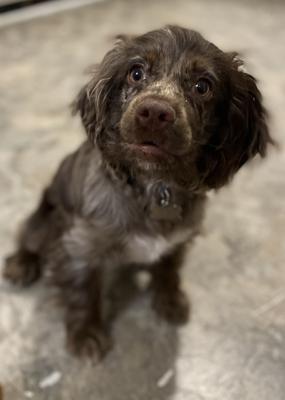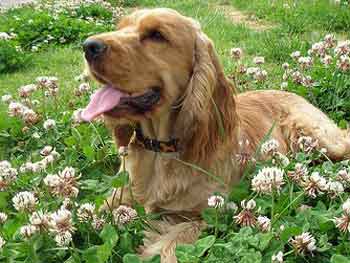- Home
- Dog Fleas and Ticks
- How to Get Rid of Fleas
How To Get Rid of Fleas on Your Dog
You want to get rid of fleas on your Cocker Spaniel, but it's not just about killing the fleas. It's also about active, ongoing flea prevention to help kill off the eggs, the larvae, and the pupa as they develop and hatch into fully grown adult dog fleas.
Read on to learn how it's done!
Get Rid Of Fleas - Permanently!
No one said getting rid of fleas was going to be easy!
Dog fleas are one of the most annoying parasites that will ever find their way into your home, and they can be a nightmare to get rid of!
They spend most of their time in your dog's coat but will also take up residence in your carpets, crevices in your floorboards, and underneath low furniture, such as your sofa.
In fact, you'll find them anywhere where it's warm and dark.
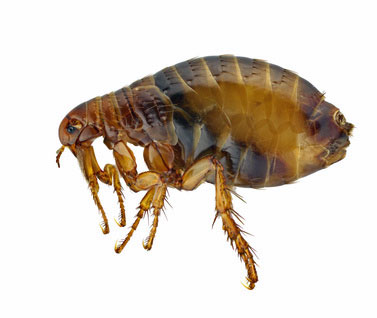 How to get rid of fleas on your dog
How to get rid of fleas on your dogUnderstanding The Fleas Life Cycle
Before you can tackle flea removal from your home, you must first understand the life cycle of dog fleas; once you do, you'll realize that one treatment may not always be enough.
The first treatment will kill off the adult fleas. You will also need to continue with further treatments until all eggs, larvae and pupa are removed or have developed into adult fleas and killed off.
Let's get straight to it and learn how to get rid of fleas on your dog's coat and banish them for good!
How To Get Rid Of Fleas On Your Dog
Step 1: Bathe Your Dog
Begin by bathing your dog; wash him thoroughly, making sure you create lots of soap suds and rub them into all the nooks and crannies.
Many specialist shampoo treatments for dog fleas are available, or your vet may recommend one.
This is an excellent way of getting rid of fleas because they can't get a grip on the hair, and they literally drown in the watery soap suds!
Don't rinse your dog's coat at this stage because you want the shampoo to get working and do its job. Leave the shampoo on for 10 to 15 minutes or however long the manufacturers recommend.
Step 2: Comb Your Spaniel's Coat
Using a flea comb, work through your dog's wet, soapy coat, section by section, to remove as many remaining fleas or eggs as possible.
Keep a separate bowl of soapy water nearby and dip the comb into the bowl after combing each section to clean the comb and 'drown' the fleas.
You may see fleas coming up to the top of your Cocker Spaniel's coat as you work. Just pick them off and put them in the bowl of soapy water.
If you choose to shampoo his coat a second time (or the manufacturers recommend it), comb through your dog's coat a second time to remove as many fleas as possible.
Step 3: Rinse Your Cocker Spaniel Thoroughly!
When you've finished washing and combing your dog's coat, rinse him several times to ensure all traces of the soap are removed.
Leaving soap in your pet's coat could cause itching or other skin problems, particularly if the flea shampoo is heavily medicated. Be sure to rinse your dog's coat well.
When you're sure there are no more soap suds, dry your dog thoroughly, paying particular attention to his ears, 'armpits', and under his tail, as these are places where dog fleas love to feed.
If parts of his coat are left damp, these warm, moist areas may encourage the fleas to lay more eggs.
Step 4: Apply Dog Flea Medication
I'm sure we all agree that getting rid of fleas isn't easy, and once you've managed it, the last thing you want is for those pesky fleas to return.
You can help to avoid a repeat infestation by applying monthly flea treatment to your Spaniel.
Some treatments will only kill adult fleas. This means that the eggs, larva and pupa continue to develop into adult fleas, resulting in a much longer timeframe to get rid of fleas on your Cocker.
However, other treatments are available that will kill fleas and stop any further development of eggs, larvae and pupa.
This treatment is much more effective at killing and removing all traces of dog fleas. It is more expensive, and you will probably need a prescription from your vet.
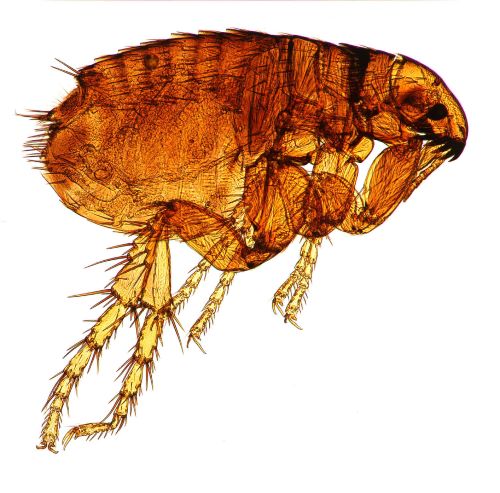 Close-up of Dog Flea - Yuk!
Close-up of Dog Flea - Yuk!Applying Dog Flea Treatment
Your dog's flea medication must be applied in the right way if it's going to be fully effective. Don't waste your money. Learn how to use flea control treatments properly and help keep your dog safe from those bloodsucking parasites.
Before Applying Flea Medicine
Before applying flea medication, it's best to read the manufacturer's instructions carefully and follow the general guidelines below.
You might also want to check with your vet to be confident that you're using the most effective type of flea medicine for your Cocker Spaniel.
It's important to bathe your Cocker Spaniel before applying the treatment because flea treatments are more easily absorbed if your dog's coat is clean.
Applying Flea Medication
Apply the treatment directly onto your dog's skin (not his coat); otherwise, it won't be as effective. Yes, this can prove tricky, especially if your little darling won't sit still and insists on wriggling, but try anyway.
Part his coat with your finger and thumb or two combs (whichever's easiest for you) and apply the liquid around his neck or in a line between the shoulder blades.
I usually do it in three or four places to ensure his coat isn't absorbing the liquid. If any liquid remains in the pipette, empty it somewhere equally out of his reach, i.e. further down his back.
Continue Using Dog Flea Treatment
Keep your Cocker Spaniel indoors until the medication is dry and absorbed by his skin; otherwise, your dog may rub it off after his first roll in the grass or the dirt.
It's what Cockers do, isn't it?
So, bear in mind these points after you've given your dog flea treatment:
- Keep your pet out of water for a few days to allow the flea treatment to get into his system, even with alleged waterproof applications;
- don't let your children stroke or pet the dog immediately after applying the medication for obvious reasons;
- always wash your hands thoroughly after applying flea treatment.
Summary: How to Get Rid of Fleas Permanently
After treating your dog for fleas, you may continue to see a few adult fleas as the immature forms continue to develop (unless you've used a treatment that halts this development).
If you are still seeing fleas, continue bathing your boy and using the flea comb until you're confident that no more fleas or eggs are present.
Once you've managed to get rid of these pesky critters and have the fleas under control, check your pet's coat often and keep a watchful eye open for tell-tale scratching.
You can always check your dog's coat each time you groom your Cocker Spaniel.
Continue using preventative flea control each month to help keep him clear. You can pick up many effective flea treatments online or in good pet stores.
Alternatively, your vet may prescribe something for you, or you can ask him about natural flea control if you prefer a more holistic approach.
Getting Rid Of Fleas In The House
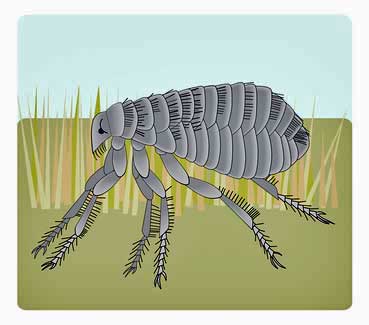 Removing dog fleas in the house
Removing dog fleas in the houseUnfortunately, getting rid of fleas on your dog is only the first step.
You'll also want to be sure that you get rid of fleas lurking in your home and prevent them from re-infesting your pet!
Learn how to banish those pesky parasites from your home...for good!
Photo credits for How to Get Rid of Fleas on your Dog:
1. Cosmin Manci at https://www.fotolia.com/id/30120482
2. Olikim at https://www.istockphoto.com/photo/dog-flea-gm172229368-2937031

